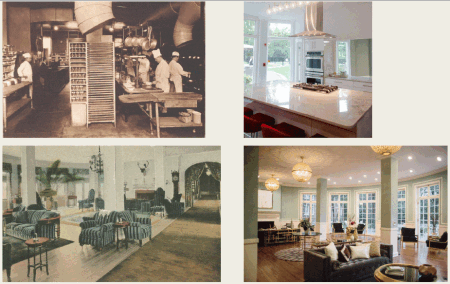In the six years since Philadelphia began to slowly reverse decades of population loss, the city has seen its share of real estate development controversies. Most of these—involving questions of gentrification, tax abatements, and density—would be familiar in any number of U.S. cities that have undergone a resurgence in the past few years. But lately, discussions about the preservation and demolition of the city’s thousands of historic properties have been particularly pitched.
In January, ULI Philadelphia hosted a panel discussion titled “Preserving the Past and Building the Future” at Villanova University, just outside Philadelphia. Moderator Antonio Fiol-Silva, founding principal of SITIO architecture + urbanism, said the discussion should serve as a “dress rehearsal for a broader conversation that has to be held in the city.” Fiol-Silva was joined on the panel by Jackie Buhn, president of AthenianRazak; Bobby Fijan, principal of Cross Properties; and Paul Steinke, executive director of the Preservation Alliance and former general manager of Reading Terminal Market.
The panelists dug into questions of how developers can make preservation projects work financially, but they also touched on a foundational issue: why it is even worth trying to preserve historic buildings. Historic buildings have unique aesthetic value and can reinforce a sense of place in communities, and working to preserve and reuse them is often better for the environment than demolishing and building anew. But there are economic reasons to pursue preservation, as well.
Between 2001 and 2014, federal historic tax credits worth $351 million were awarded to 277 projects in Philadelphia, said Steinke, citing figures from a report prepared by the Historic Tax Credit Coalition and the National Trust for Historic Preservation. These projects represent $2.1 billion in development costs and 32,000 construction and permanent jobs, according to the report. During that same period, tax credits were granted for 41,000 projects nationwide representing $78 billion of private investment.
Buhn walked the audience through the process of applying for federal historic tax credits, which are available for properties listed on the National Register of Historic Places or contributing properties in a historic district. Developers hoping to claim the credits must prove first that the building is historic—either architecturally significant or associated in some way with historic people or events. They then have to prove that the proposed work meets the standards of the National Park Service (NPS). Finally, they have to show that they did the work they said they would do. When the final criterion is met, the developer may receive historic tax credits worth about 20 percent of construction costs.
Qualifying for the tax credits is not always as straightforward as it sounds, said Fijan, whose company in 2012 purchased an estate called the Palmer in Wynnewood, a community in the western suburbs of Philadelphia. After getting the property listed on the National Register, Cross Properties applied for historic tax credits to renovate it. Fijan said the firm initially was denied at both the second and third steps—proving the proposed work met NPS standards and that the firm did the work it said it would—but ultimately earned the credits after appealing those decisions. In the end, Cross was able to sell $6 million worth of tax credits to a private insurance company, offsetting the cost of the project.
Aside from the uncertainty and risk involved in individual preservation projects, some overall threats are looming as well. Many preservationists fear the erosion or total loss of the federal historic tax credit under the new administration, along with other programs like New Markets Tax Credits and Low-Income Housing Tax Credits. Even if those programs are left untouched, though, panelists pointed out that any major reduction in corporate taxes overall could weaken the market for all tax credits, reducing the incentive to preserve historic structures.
An example of the good that historic tax credits can do can be found at the Divine Lorraine Hotel on North Broad Street, one of the most beloved buildings in Philadelphia. Vacated in the late 1990s, the 120-year-old Divine Lorraine will soon be reopened as apartments after a $41 million renovation by developer Eric Blumenfeld. Revival of the building, which was empty for more than 15 years, was spurred by about $10 million in historic tax credits.
The Divine Lorraine is a Philadelphia success story, but many other historic properties in the city are threatened. The most recent controversy involves Jewelers Row, a quaint, one-block stretch of buildings near Washington Square and Independence Mall. Over the summer, developer Toll Bros. announced plans to demolish a series of buildings and replace them with an apartment tower. Though there is outcry from preservationists and opposition from Philadelphia Mayor Jim Kenney, the buildings are not listed on the local register of historic places, the only mechanism by which historic properties can be protected from demolition.
The potential loss of Jewelers Row illustrates the vulnerability of Philadelphia’s preservation environment, Steinke said. He hopes that more resources will be dedicated to the Philadelphia Historical Commission—which is underfunded relative to such commissions in many of its peer cities—so it can develop a citywide inventory of historic places.
In the meantime, as Philadelphia experiences a sustained development boom, many historic assets are at risk. Not only was Jewelers Row unlisted on the local register, but the site also carries the most permissive zoning designation in the city. The threat stems from the combination of a strong market, weak preservation infrastructure, and zoning classifications that make many historic properties more valuable as empty land.
Fiol-Silva, who also serves on the Philadelphia Historical Commission, wrapped up the panel by asking the speakers what they would do if Jewelers Row were their own property. All acknowledged that, with the market and zoning incentives being what they are, it is tough to blame the developer for wanting to tear the buildings down. But, “just because it’s as-of right doesn’t make it right,” Steinke said.
“Of course, self-interest dictates ‘sell to the highest bidder,”’ he said. “But the public interest can sometimes dictate something different, and that is preservation and the retention of historic fabric.”
The discussion should not come down to a “moral choice” between preservation and property rights, Fiol-Silva said. Instead, it should revolve around more nuanced issues: Can the facade be preserved? Can the development rights be sold to another site?
Buhn noted that the existing use, with many jewelers’ workshops as well as retail stores, is likely to begin to change in response to the increasing value of Center City land, and that this use is a large part of the attraction of the block. She also noted that structures and scale could be preserved or replicated, but preserving uses is more difficult. “Cities change,” she said.
But all agreed that the conversation may be moot if the incentives of the federal historic tax credits are not maintained. “In the end, if the tax credit is weakened, much of meaningful preservation—and the economic development and city rebuilding that it has enabled—is toast,” Fiol-Silva said.







